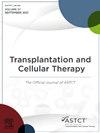美国移植和细胞治疗学会系列:#8-造血细胞移植受者非曲霉霉菌的管理和预防。
IF 3.6
3区 医学
Q2 HEMATOLOGY
引用次数: 0
摘要
美国移植和细胞治疗学会的实践指南委员会与其移植感染性疾病特别兴趣小组合作,制定了一项针对非曲霉菌侵袭性霉菌的指南,这是一种罕见但致命的侵袭性真菌疾病,发生在hct前后。我们使用概要式的方法,将这个广泛、异构且高度复杂的主题分解为一系列独立的常见问题(FAQs)和表格。成人和儿童传染病和HCT内容专家开发,然后回答常见问题,并最终确定主题与统一的建议。NAIMI的所有证据都是非rct的,而且大多是III级,因此没有推荐等级,而是提供了关键参考文献。通过这种形式,本系列的“第八”主题侧重于移植前后罕见霉菌感染的相关风险因素、诊断考虑、预防和治疗方法。本文章由计算机程序翻译,如有差异,请以英文原文为准。
American Society of Transplantation and Cellular Therapy Series: #8-Management and Prevention of Non-Aspergillus Molds in Hematopoietic Cell Transplantation Recipients
The Practice Guidelines Committee of the American Society of Transplantation and Cellular Therapy partnered with its Transplant Infectious Disease Special Interest Group to create a guideline focusing on non-Aspergillus invasive molds, which are uncommon yet lethal invasive fungal diseases in the peri-hematopoietic cell transplant (HCT) period. We used a compendium-style approach by dissecting this broad, heterogeneous, and highly complex topic into a series of standalone frequently asked questions (FAQs) and tables. Adult and pediatric infectious diseases and HCT content experts developed, then answered FAQs, and finalized topics with harmonized recommendations. All the evidence for non-Aspergillus invasive mold infection is non-RCT and mostly level III, therefore there are no recommendation grades, and instead key references are provided. Through this format, this “8th” topic in the series focuses on the relevant risk factors, diagnostic considerations, prophylaxis, and treatment approaches relevant to rare mold infections in the pre- and post-transplant periods.
求助全文
通过发布文献求助,成功后即可免费获取论文全文。
去求助
来源期刊

Transplantation and Cellular Therapy
Medicine-Hematology
CiteScore
7.00
自引率
15.60%
发文量
1061
审稿时长
51 days
 求助内容:
求助内容: 应助结果提醒方式:
应助结果提醒方式:


